Discover the Wealden Heath SPA
Walking in the Wealden Heaths
A collection of walking routes and sites to explore has been curated for those wanting to Discover the Wealden Heaths. These include:
- A circular ‘Rail to Ramble’ walk around Weavers Down starting at Liphook railway station. Here you may be lucky to spot heathland specialists such as the Dartford warbler, woodlark and nightjar. Approx 7 miles.
- A shorter version of this walk called the Deer’s Hut loop is also available on the leaflet. Approx 3.1 miles.
- A chance to explore Shortheath Common – walk around this fascinating site, home to the extremely rare ‘quaking bog’ and habitat for some nationally rare plant and animal species. Approx 2 miles.
- The family-friendly recreational site of Hogmoor Inclosure near Bordon, with signposted accessible trails, café and play area. Approx 1.3 miles, 3 different trails.
Wildlife of the Wealden Heath Special Protection Area
Heathland is a haven for some of Britain’s rarest wildlife.
An open unique landscape teeming with hidden treasures and historical tales, no two heaths are the same.
Here are some of the species you can find in the Wealden Heath Special Protection Area.
Dartford Warbler
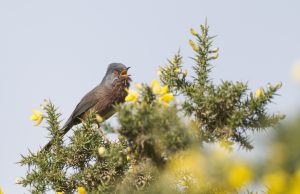
Its distinctive rusty breast, long tail and the scratchy song it sings from the tops of gorse bushes identify this small grey heathland bird which can be spotted all year round.
The Dartford warbler is sensitive to cold harsh winters.
Their population crashed to a few pairs in the 1960s, since then, it has gradually recovered, increasing in both numbers and range. It is still regarded as an Amber List species.
These small birds are one of several species that nest on the ground rather than in trees.
Sand Lizard
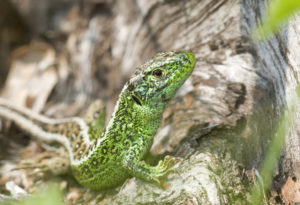 Sand Lizards are one of the UK’s rarest reptiles.
Sand Lizards are one of the UK’s rarest reptiles.
They occupy some of our sandy heaths as they enjoy basking in the sunshine on mossy, heather covered banks.
They prey on insects and spiders.
In the spring during mating season – April to late May, males turn an exotic bright green colour in order to attract a mate. Sand lizards dig test burrows into bare sand to check the conditions are right before they lay their eggs.
Sometimes you may see ‘scrapes’ which are areas where the vegetation has been removed to reveal bare soil, this is to provide areas for Sand lizards to lay their eggs, so please do not walk on them.
Silver Studded Blue Butterfly
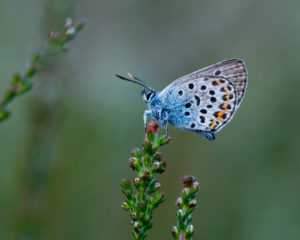 The silver studded blue is a rare small blue butterfly found on heathland and sand dunes in southern England.
The silver studded blue is a rare small blue butterfly found on heathland and sand dunes in southern England.
Males are blue with a dark border and females are brown with a row of red spots.
The silvery blue males can be spotted fluttering low over the heather in July and August. Most adults move less than 20m per day.
The caterpillar feeds off both bell and cross-leaved heather and gorse.
European Nightjar
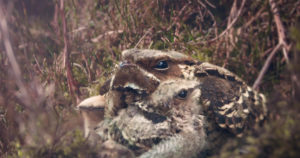 A master of camouflage, the nightjar is a ground-nesting bird that migrates long distances from Africa to breed and nest on our lowland heath in the spring.
A master of camouflage, the nightjar is a ground-nesting bird that migrates long distances from Africa to breed and nest on our lowland heath in the spring.
Their plumage is a grey brown colour and makes for perfect camouflage in the heather.
They feed on nocturnal insects such as flies, moths and beetles, using the hairs around their mouths to detect their prey’s wingbeats.
During breeding season (April-August) males put on quite a show by making a unique “churring” sound and loudly clap their wings together to mark their territories.
Natterjack Toad
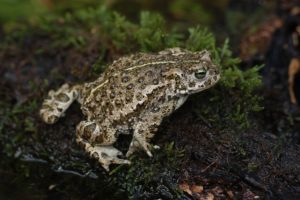 The natterjack is smaller than the more widespread common toad measuring approximately 60-70mm.
The natterjack is smaller than the more widespread common toad measuring approximately 60-70mm.
They have a yellow line down back and they walk rather than hop.
They feed on invertebrates and need a shallow pond with very little vegetation and very specific conditions of a pH of 5-7. It is an offence to disturb a Natterjack.
They used to be quite common on the heaths of Surrey and Hampshire and also around the coast of East Anglia but sadly only one or two colonies now remain.
Re-introduction programmes have now started to restore the range of this animal and a small population are set to be re-introduced to Blackmoor in 2022.
Woodlark
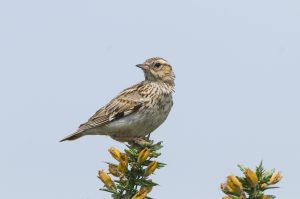 The woodlark is another bird, which builds its nest on the ground on the heath in the south of England.
The woodlark is another bird, which builds its nest on the ground on the heath in the south of England.
It is a small mottled brown bird with a distinctive black and white mark on the edge of its wings. The secretive woodlark can be hard to spot.
Their musical song can be heard by day or night, particularly between March and August.
These birds nest earlier in the year than others, sometimes before the end of March and females can raise several broods each year.
Smooth Snake
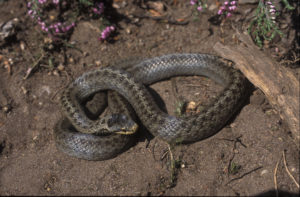 The smooth snake is the UK’s rarest reptile.
The smooth snake is the UK’s rarest reptile.
They can be found mainly on south facing slopes on dry heathland sites in the Special Protection Area.
Smooth snakes usually have a heart-shaped crown marking which covers the top of their head.
They prey on other reptiles, particularly lizards but also other snakes, which they kill by constriction.
Heather bell, cross-leaved and ling
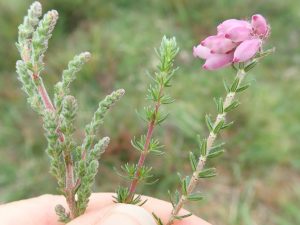
Our lowland heath is home to three types of heather.
- Cross-leaved heather prefers wetter ground and gets its name from the way that the pale green leaves are arranged around the stem.
- Ling and bell heather are more commonly found and you can tell them apart by the position and colour of the flowers.
- Bell heather has dark purple flowers that cluster in groups along the stem, whereas ling has lots of very little flowers all the way up the longer stems. The Latin name for ling, Calluna, comes from a Greek work meaning ‘to brush’ which relates to the fact that heather was once used to make sweeping brooms or ‘besoms’.
All three types are extremely important for providing a food source and shelter for a variety of heathland invertebrates, reptiles and birds.
Sundew
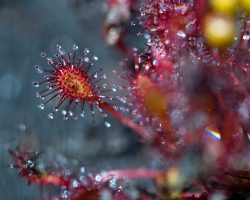 This tiny insectivorous plant uses sticky dew drops secreted from its hairy leaves to trap insects that land on them.
This tiny insectivorous plant uses sticky dew drops secreted from its hairy leaves to trap insects that land on them.
The round leaves slowly curl around the insect, digesting the prey.
Absorbing these nutrients helps sundews to survive on the nutrient-poor heathland soil.
Typically found on wetter areas of the heath, the dew was once collected by people for use as an antiaging cream!
Field Cricket
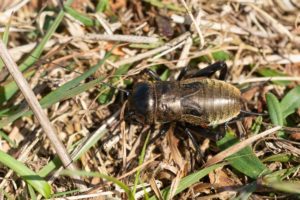 Rare black or brown cricket with striking yellow wing bases.
Rare black or brown cricket with striking yellow wing bases.
They can’t fly but can walk up to 100 metres a day.
Two cm long, their wing markings resemble intricate wrought-iron work.
The males make a loud chirruping call to attract a mate using ‘harps’, modified veins on their wings.
The sound of the Field cricket was once common across the area but numbers suffered such a decline that they are now part of a Back to the Brink project and have recently be re-introduced to sites in the Wealden Heath Special Protection Area.
Being wildlife aware
Many of our heathland specialists are particularly vulnerable to disturbance as their camouflage makes them difficult to notice.
Inquisitive dogs can trample nests or frighten the birds into abandoning their nests.
As a result, we kindly ask when walking on the heath to stick to the main paths and please keep your dog on a lead or under close control during ground nesting season (March-September).
